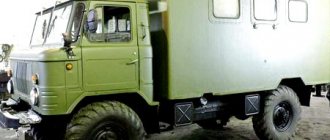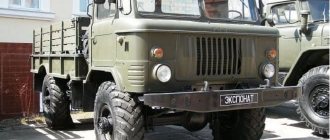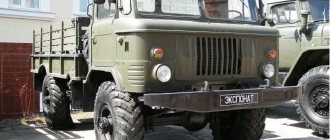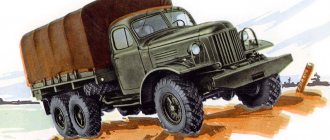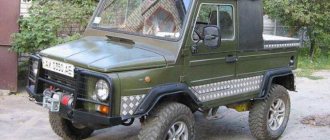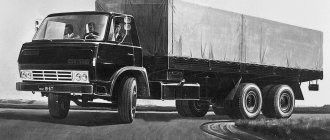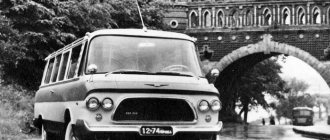Author: BuG
01 March 2022 11:10
Tags: auto stories facts
10531
22
More than 50 years ago, GAZ began production of the legendary GAZ-66 truck.
Car enthusiasts are like children, only their toys are more expensive, someone once said. The habit of giving nicknames to all common cars took root a long time ago. “Kopeyka”, “Loaf”, “Goat” - all these nicknames dear to our hearts are well known. AZ-66 was dubbed “Shishiga” for its similarity in sound to the word “sixty-sixth”. Production of the GAZ-66 all-wheel drive cabover truck began in November 1963. As always, the birth of legendary cars is accompanied by some mystery, or at least an unusual story, generously seasoned with details. It was the same with '66. One of the common tales is that the GAZ-66 was invented by a woman. Like, it’s inconvenient, and the gear shift is unusual, and the wheels are under the driver. These are all “legends”. And it all started like this: on August 3, 1956, in the exposition of new models exhibited at the then All-Russian Agricultural Exhibition (then VDNKh, and now the All-Russian Exhibition Center), the GAZ-62 cargo-passenger SUV was presented. Outwardly, it resembled the well-known Lend-Lease army Dodge-3/4. But neither the army nor agriculture showed much interest in the car.
Evolution of GAZ 62
0
See all photos in the gallery
×
The design of the GAZ-62 was developed by A.D. Prosvirnin, who at that time held the position of deputy chief designer for trucks at the GAZ association. Prosvirnin was able to take into account the wishes of customers and created a cargo version of the GAZ-62, with a 4x4 wheel arrangement and a carrying capacity of 1 ton. The cabin was located above the engine. Various modifications of such a car were tested with self-locking differentials, and with sealed brakes, and with an engine with pre-chamber-torch ignition of the combustible mixture. As a result of the work, the optimal option for an engine with pre-chamber-torch ignition was found, and in 1959-1960 GAZ produced a batch of several hundred GAZ-62 cars. Operation of this experimental batch showed insufficient power of the six-cylinder engine. The Gaz-51 engine was no longer suitable. By that time, the plant already had the design of a promising V-shaped 8-cylinder engine with a crankcase and cylinder head made of aluminum alloy, and preparations were underway for its mass production. Work on further development of the GAZ-62 design in relation to the capabilities of the new engine was carried out in parallel with the development of the engine. The first prototype of the future GAZ 66 appeared in 1956. An experimental model of an all-terrain vehicle with a modified tail of the produced 51/63 cabin. The vehicle is built on the GAZ 63V platform with a widened track.
"Shishigi" design
The design of the new multi-purpose vehicle incorporated the best technical ideas of that time. The engine is carburetor type. 8 cylinders consume AI-76 or AI-80 fuel. There are options designed for diesel fuel, but they are few.
Due to the V-shaped engine, the small size of the structure was achieved.
The engine power is 120 horses, and the weight is 262 kilograms. For cold weather, an engine preheating system has been developed.
The hydraulic brake system on the GAZ-66 is equipped with a vacuum booster and is highly reliable, however, it is not possible to coast when the engine is turned off. The steering system is equipped with a hydraulic booster. This makes it possible to better control the sixty-sixth on any difficult tracks.
The gearbox has 4 phases. Speeds 3 and 4 are synchronized. When driving on steep slopes, you can use a reduction divider. When driving on good road surfaces, the driver can disable the front axle. Eliminating all-wheel drive saves fuel. Drum brakes. The handbrake operates on all wheels.
The cabin is located above the wheels and power unit.
There are two seats in it, for the driver and the eldest of the car. If necessary, there is a mount for hanging a hammock. Access to the engine is also through the cab; it needs to be tilted forward for better access to the engine.
The cabin design itself is famous for its lack of comfort. The high seating position also allows for a lot of bumps on uneven roads for an inexperienced or tall driver.
Separately, it is worth mentioning the landing version of the GAZ-66B, with a canvas folding cab top; this vehicle could be parachuted along with airborne units. The landing was carried out from the Il-76, while the vehicle itself was mounted on a platform of the PP-128-00-5000 type, equipped with a parachute system.
On the basis of the GAZ-66B, vehicles for transporting soldiers were produced, as well as shortened MLRS systems of the “Grad” type; the equipment itself was used for transporting towed guns.
Its adoption significantly increased the mobility of airborne units after landing.
Its use was somewhat limited only by the mass of towed artillery systems; with the improvement of weapons, the mass increased. For this reason, the GAZ-66B did not last long in service.
The body depends on the type of car. They installed a wooden platform, an awning, and tanks. KUNG (Unified Sealed Body) is especially popular to this day.
GAZ 66 Experienced 1956
0
In 1958, a second experimental model was released, already more similar to the final version of Shishigi. Initially, the technical model was conceived to be unified with the GAZ 53 in terms of engine and chassis. GAZ 66 was developed in the late 1950s. in parallel with the GAZ 62, with which it had a common layout and cabin. The lead designer of the machine is Rostislav Grigorievich Zavorotny. The author of the cabin design is Lev Mikhailovich Eremeev. At the initial design stage, the vehicle was designated as GAZ 68 - the index 66 was assigned to experimental all-terrain vehicles with a bonnet design based on the GAZ 63.
Trace in culture
GAZ-66 is one of the legends of the Soviet automobile industry. Few cars can boast of such popularity among the military, geologists, shift workers and those who, due to their duty or work, are obliged to deal with off-road conditions and live in the field.
The best indicator of popularity is the rating of requests in automobile markets, where “Shishiga” is in constant demand.
Unfortunately, the price of fuel plays a big role. As noted, the car is gluttonous. Because of this, neither the excellent maneuverability nor the comfort of the KUNG saved her.
GAZ 66 Pre-production 1962
0
GAZ-66 is an off-road truck with a carrying capacity of 2 tons, designed for driving in difficult road conditions and off-road. High cross-country ability is due to the use of self-locking differentials on the front and rear axles, high ground clearance and adjustable tire pressure (the wheels have a special design); an engine-driven compressor is installed to inflate the tires. The car engine is equipped with a PZHB-12 pre-heater. The service brake system is hydraulic separate with a vacuum booster, the parking system is a drum transmission brake. Hydraulic power steering. The car had a low center of gravity, which made it stable on slopes. Almost equal load on the front and rear axles and compactness due to the cabin above the engine, due to which the vehicle was widely used in airborne troops, as it lands on all wheels at once and descends without blocking the cabin. This version of the car had a canvas top cabin and a windshield that folded horizontally.
Vehicle application
From the moment it left the production line, the GAZ-66 found many fans among workers and military people. The Airborne Forces received an excellent cross-country vehicle. Thanks to its balance, it did not fall over after landing during the airdrop. The command and staff vehicle (CSV), necessary for large-scale landing operations, was received.
True, the further military fate of the “sixty-sixth” did not work out. In a combat situation, it quickly became clear that hitting a mine meant the loss of the driver.
It is for this reason that the GAZ-66 was not popular in OKSVA; in conditions of a mine war on the roads, the car showed complete failure.
The “shishiga” is gradually being abandoned, but for the military it remains a legend.
The maneuverability impressed not only the Americans, but even our seasoned soldiers and officers. Particularly appreciated was the tire pressure regulation system, so necessary in the military environment.
The “sixty-sixth” was of great importance for the national economy. In whatever difficult situation the work was carried out, this particular machine could get there. The installed winch made the vehicle's maneuverability even higher.
The main disadvantage was the gasoline engine, which consumed 24 liters per 100 kilometers. Drivers will understand that these are approximate numbers and are prone to increase.
GAZ 66B ready for loading.
0
The 8-cylinder engine developed a power of 115 hp. The car reached speeds of up to 90 km/h on the highway, confidently took slopes up to 30% steep and overcame a ford up to 1 meter deep. The machine has proven itself in the most difficult operating conditions, severe temperature conditions and in a wide variety of areas in military and civil service. In 1985, the car was modernized, and subsequently 2 versions were released: with and without a winch, respectively under the symbols GAZ-66-12 and GAZ-66-11. The plant also planned to produce a three-axle version of the GAZ-34 and GAZ-33 trucks with a wheel formula of 6x6 and 6x4, respectively. Their tests began in 1965. But the main customer, the Ministry of Defense, did not consider it necessary to give the green light to these models, believing that the ZIL-131, with a payload of 3.5 tons, was more suitable for army needs. Also, the limited internal volume of the cabin and its location directly above the wheels turned out to be dangerous for the crew in the event of a mine explosion, so the GAZ-66, starting in the 1980s, was withdrawn from combat units in Afghanistan.
GAZ 34
0
There were many modifications based on the GAZ-66. • GAZ-66-1 (1964-1968) - the first trucks without a tire inflation system • GAZ-66A (1964-1968) - the presence of a winch • GAZ-34 - a truck without GAZ-66 with a 6x6 wheel arrangement PHOTO • GAZ-66B (since 1966) - landing version with a folding roof • GAZ-66D (1964-1968) - chassis with power-adjustable gearbox PHOTO • GAZ-66P - prototype of a truck tractor PHOTO • GAZ-66E (1964-1968) - shielded equipment • GAZ -66-01 (1968-1985) - model with central tire inflation • GAZ-66-02 (1968-1985) - with a winch • GAZ-66-03 (1964-1968) - shielded equipment • GAZ-66-04 ( 1968-1985) - shielded equipment • GAZ-66-05 (1968-1985) - shielded equipment, the presence of a winch • GAZ-66-11 (1985-1996) - modernized version • GAZ-66-12 (1985-1996) - the presence of a winch • GAZ-66-14 (1985-1996) - shielded equipment • GAZ-66-15 (1985-1996) - shielded equipment, the presence of a winch • GAZ-66-16 (1991-1993) - with a ZMZ-513.10 engine , load capacity 2.3 tons • GAZ-66-21 (1993-1995) - double rear wheels for the national economy, load capacity 3.5 tons • GAZ-66-31 - dump truck chassis PHOTO • GAZ-66-41 (1992- 1995) - diesel GAZ-544 • GAZ-66-40 (1995-1999) - turbodiesel GAZ-5441 • GAZ-66-92 (1987-1995) - northern version • GAZ-66-96 - rotation bus PHOTO Export modifications of GAZ -66 • GAZ-66-51 (1968-1985) • GAZ-66-52 (1968-1985) - the presence of a winch • GAZ-66-81 (1985-1995) - export version for warm countries • GAZ-66-91 (1985-1995) - export version for warm countries Specialized modifications of the GAZ-66 • AP-2 - auto-dressing, designed to provide first aid to the military PHOTO • AS-66 - sanitary version, for evacuation and transportation of the wounded. • DDA-66 - disinfection-shower unit, designed for the prevention of military and civilians during biological and chemical threats PHOTO-1, PHOTO-2 • DPP-40 - landing pontoon park, designed for building pontoon bridges across rivers PHOTO-1, PHOTO- 2 • GZSA-731, 983A, 947, 3713, 3714 - “Mail”, “Bread” and “Medicine” vans • MZ-66 - oil tanker PHOTO • R-125 - command and staff vehicle. • R-142 - command and staff vehicle. • 3902, 3903, 39021, 39031 - auto repair shop • 2001, 2002, 3718, 3719, 3716, 3924, 39521 - mobile clinics • GAZ-SAZ-3511 - agricultural dump truck on the GAZ-66-31 chassis, assembled in Saransk • GAZ-KAZ-3511 - agricultural dump truck on the GAZ-66-31 chassis, assembled in Bishkek Buses based on GAZ-66 • NZAS-3964, Volgar-39461 - comfortable rotational buses


